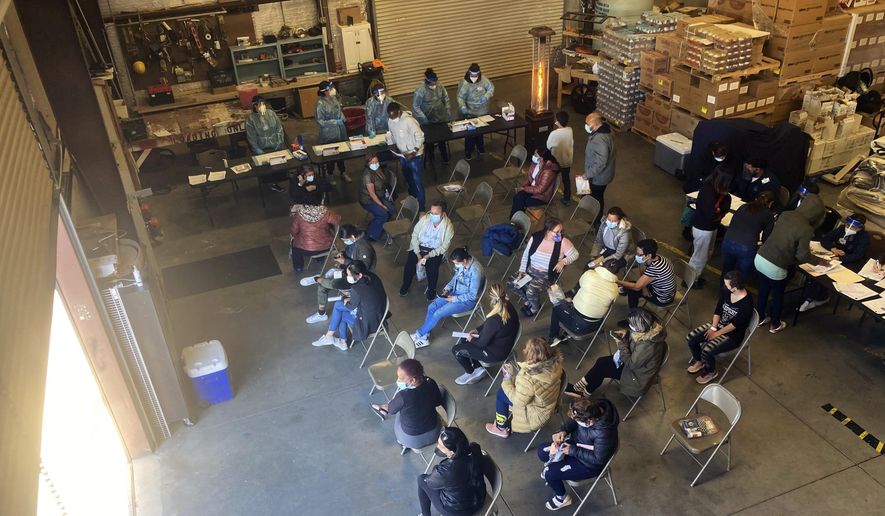ICE is getting ready to release as many as 600,000 illegal immigrants into communities before the end of September, the agency told a federal judge, giving an early estimate of the chaos the administration is predicting after it ends the Title 42 pandemic border shutdown.
U.S. Immigration and Customs Enforcement revealed the figure in a court filing dealing with how it plans to handle illegal immigrant children who arrive as part of the surge.
Deane Dougherty, ICE’s juvenile coordinator, wrote in the filing that the Homeland Security Department expects a “historic border surge, with projections forecasted to triple current arrivals.”
The coordinator said ICE expects to catch and release more than 3,000 illegal immigrants from the border every day, up from 774 a day in March.
“Given these forecasts and the recently announced decision to end Title 42 next month, ICE must shift its focus and prepare to manage its resources for a population of up to 600,000 by the end of the fiscal year,” the coordinator said.
The fiscal year runs through Sept. 30, meaning ICE expects to release more than 100,000 people a month between now and then.
SEE ALSO: Border chaos goes global as DHS nabs illegal immigrants from across the world
Homeland Security has predicted it will catch as many as 18,000 people a day crossing the border. Many of those are likely to be caught and released by the Border Patrol before even entering ICE custody, so the total number of releases could soar well above the 600,000 figure.
Together, they mark a massive increase in the level of catch-and-release.
Jessica Vaughan, policy studies director at the Center for Immigration Studies, said the caseload ICE anticipates would be unprecedented.
“This document casually reveals that the Biden catch-and-release system resulting in the resettlement of hundreds of thousands of illegal border crossers is not a strained or frenzied response to an emergency, not due to a lack of resources, and not the result of incompetence, but a deliberate and intentional policy,” she said.
ICE declined to answer questions about its estimate, saying it was part of a legal proceeding and the agency wouldn’t comment on legal matters.
Under the law, ICE can detain the migrants until their immigration hearings, but the agency is budgeted for only an average of 34,000 detention beds a day.
SEE ALSO: Report: More universities holding segregated graduation events
It has been using fewer than 20,000 beds on a consistent basis this year, even though the border has been overrun with new arrivals.
On Sunday, ICE reported 18,708 of its beds in use despite having just completed the worst month on the southern border of President Biden’s tenure.
Documents filed in a separate court case in Texas show that the Border Patrol apprehended 209,906 illegal immigrants in March and Customs and Border Protection officers at ports of entry nabbed another 11,397 unauthorized crossers.
About half were quickly expelled under the Title 42 policy, which is in effect until May 23.
Of the more than 110,000 others, CBP released more than 65,000 people on its own, returned about 12,000 under non-Title 42 provisions of the law and had about 12,500 people in custody.
CBP sent about 24,000 to ICE, which deported 345, and released 14,345 others as of March 31.
According to the ICE coordinator’s court filing, the agency now expects to release more than 100,000 a month. That would shatter records and add to an already massive backlog facing ICE.
The deportation agency had 3.6 million people on its nondetained docket as of September. That included more than 400,000 convicted criminals and at least 600,000 fugitives who are defying deportation orders.
Mr. Biden, in his 2023 budget, set a goal of reducing the backlog by 5%, or about 185,000 cases, over three years. It’s not clear whether the budget accounted for ICE’s projected releases from the upcoming border surge.
Ms. Vaughan said there are clear costs to releasing so many illegal immigrants, including coronavirus concerns and criminal worries. With so many of the illegal immigrants now coming as juveniles, immigrant-heavy gangs such as MS-13 and 18th Street are feeding off the youths to grow their ranks, she said.
“Some get drawn into gangs after arrival, but many are already involved before they come here,” she said. “The Biden administration appears unfazed by the likelihood that they are seeding U.S. communities with certain kids who are going to be contributing to crime and especially violence in schools and neighborhoods.”
Then there are the costs of monitoring.
“And for what purpose? There is no indication whatsoever that the administration intends to remove them,” Ms. Vaughan said.
A 2020 Homeland Security report found that of the million illegal immigrants who came to the U.S. as part of family units from 2014 to 2019, just 6% had been repatriated to their home countries by March 2020. Another 5% won their cases.
Another 20% were defying orders to depart and about two-thirds of cases were still unresolved as many as six years after the migrants’ arrival.
Homeland Security said the situation will be different this time.
It has announced plans to shift initial asylum decisions from immigration courts to officers at U.S. Citizenship and Immigration Services, who are expected to be more lenient and grant more cases. Homeland Security said the new process will mean faster and fairer decisions.
The department has also revealed plans to try to close a number of cases pending in ICE’s backlog by granting work permits allowing the migrants to remain and work in the U.S.
• Stephen Dinan can be reached at sdinan@washingtontimes.com.




Please read our comment policy before commenting.